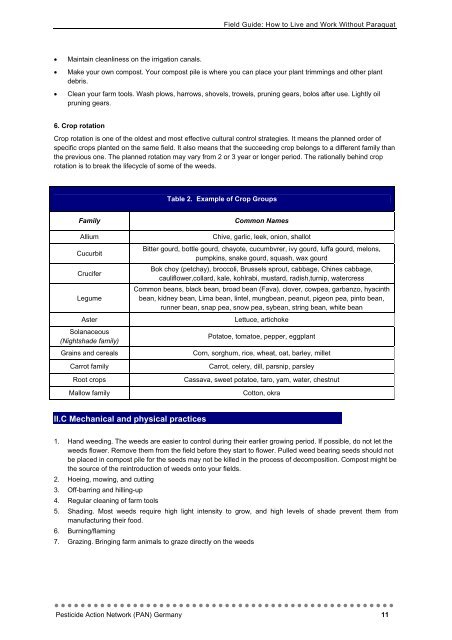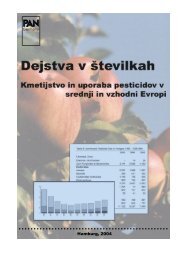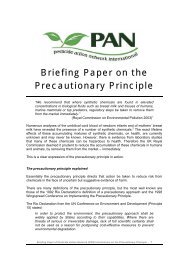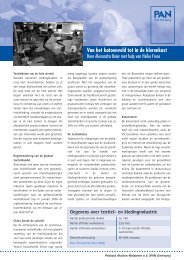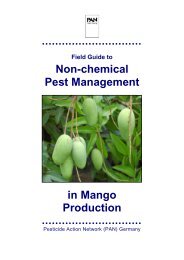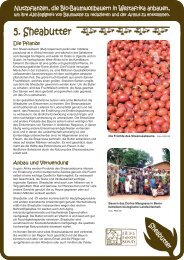Field Guide: How to Grow Crops without Paraquat - Online ...
Field Guide: How to Grow Crops without Paraquat - Online ...
Field Guide: How to Grow Crops without Paraquat - Online ...
Create successful ePaper yourself
Turn your PDF publications into a flip-book with our unique Google optimized e-Paper software.
<strong>Field</strong> <strong>Guide</strong>: <strong>How</strong> <strong>to</strong> Live and Work Without <strong>Paraquat</strong><br />
• Maintain cleanliness on the irrigation canals.<br />
• Make your own compost. Your compost pile is where you can place your plant trimmings and other plant<br />
debris.<br />
• Clean your farm <strong>to</strong>ols. Wash plows, harrows, shovels, trowels, pruning gears, bolos after use. Lightly oil<br />
pruning gears.<br />
6. Crop rotation<br />
Crop rotation is one of the oldest and most effective cultural control strategies. It means the planned order of<br />
specific crops planted on the same field. It also means that the succeeding crop belongs <strong>to</strong> a different family than<br />
the previous one. The planned rotation may vary from 2 or 3 year or longer period. The rationally behind crop<br />
rotation is <strong>to</strong> break the lifecycle of some of the weeds.<br />
Table 2. Example of Crop Groups<br />
Family<br />
Allium<br />
Cucurbit<br />
Crucifer<br />
Legume<br />
Aster<br />
Solanaceous<br />
(Nightshade family)<br />
Grains and cereals<br />
Carrot family<br />
Root crops<br />
Mallow family<br />
Common Names<br />
Chive, garlic, leek, onion, shallot<br />
Bitter gourd, bottle gourd, chayote, cucumbvrer, ivy gourd, luffa gourd, melons,<br />
pumpkins, snake gourd, squash, wax gourd<br />
Bok choy (petchay), broccoli, Brussels sprout, cabbage, Chines cabbage,<br />
cauliflower,collard, kale, kohlrabi, mustard, radish,turnip, watercress<br />
Common beans, black bean, broad bean (Fava), clover, cowpea, garbanzo, hyacinth<br />
bean, kidney bean, Lima bean, lintel, mungbean, peanut, pigeon pea, pin<strong>to</strong> bean,<br />
runner bean, snap pea, snow pea, sybean, string bean, white bean<br />
Lettuce, artichoke<br />
Pota<strong>to</strong>e, <strong>to</strong>ma<strong>to</strong>e, pepper, eggplant<br />
Corn, sorghum, rice, wheat, oat, barley, millet<br />
Carrot, celery, dill, parsnip, parsley<br />
Cassava, sweet pota<strong>to</strong>e, taro, yam, water, chestnut<br />
Cot<strong>to</strong>n, okra<br />
II.C Mechanical and physical practices<br />
1. Hand weeding. The weeds are easier <strong>to</strong> control during their earlier growing period. If possible, do not let the<br />
weeds flower. Remove them from the field before they start <strong>to</strong> flower. Pulled weed bearing seeds should not<br />
be placed in compost pile for the seeds may not be killed in the process of decomposition. Compost might be<br />
the source of the reintroduction of weeds on<strong>to</strong> your fields.<br />
2. Hoeing, mowing, and cutting<br />
3. Off-barring and hilling-up<br />
4. Regular cleaning of farm <strong>to</strong>ols<br />
5. Shading. Most weeds require high light intensity <strong>to</strong> grow, and high levels of shade prevent them from<br />
manufacturing their food.<br />
6. Burning/flaming<br />
7. Grazing. Bringing farm animals <strong>to</strong> graze directly on the weeds<br />
••••••••••••••••••••••••••••••••••••••••••••••••••••<br />
Pesticide Action Network (PAN) Germany 11


